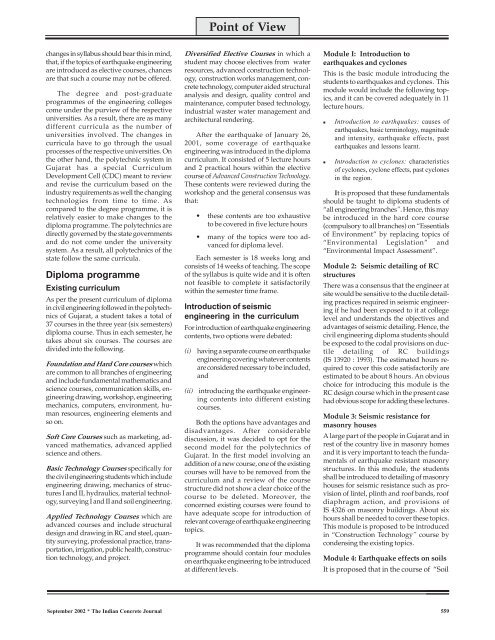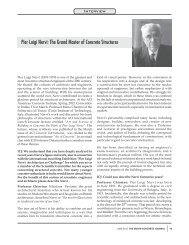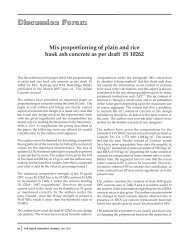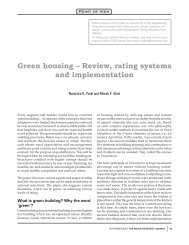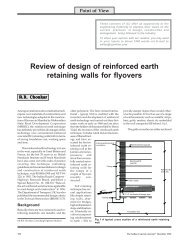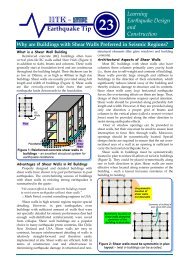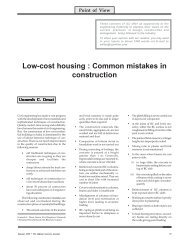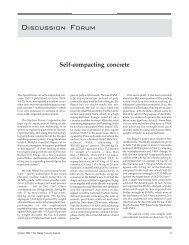Earthquake engineering in the civil engineering curricula
Earthquake engineering in the civil engineering curricula
Earthquake engineering in the civil engineering curricula
Create successful ePaper yourself
Turn your PDF publications into a flip-book with our unique Google optimized e-Paper software.
changes <strong>in</strong> syllabus should bear this <strong>in</strong> m<strong>in</strong>d,<br />
that, if <strong>the</strong> topics of earthquake <strong>eng<strong>in</strong>eer<strong>in</strong>g</strong><br />
are <strong>in</strong>troduced as elective courses, chances<br />
are that such a course may not be offered.<br />
The degree and post-graduate<br />
programmes of <strong>the</strong> <strong>eng<strong>in</strong>eer<strong>in</strong>g</strong> colleges<br />
come under <strong>the</strong> purview of <strong>the</strong> respective<br />
universities. As a result, <strong>the</strong>re are as many<br />
different <strong>curricula</strong> as <strong>the</strong> number of<br />
universities <strong>in</strong>volved. The changes <strong>in</strong><br />
<strong>curricula</strong> have to go through <strong>the</strong> usual<br />
processes of <strong>the</strong> respective universities. On<br />
<strong>the</strong> o<strong>the</strong>r hand, <strong>the</strong> polytechnic system <strong>in</strong><br />
Gujarat has a special Curriculum<br />
Development Cell (CDC) meant to review<br />
and revise <strong>the</strong> curriculum based on <strong>the</strong><br />
<strong>in</strong>dustry requirements as well <strong>the</strong> chang<strong>in</strong>g<br />
technologies from time to time. As<br />
compared to <strong>the</strong> degree programme, it is<br />
relatively easier to make changes to <strong>the</strong><br />
diploma programme. The polytechnics are<br />
directly governed by <strong>the</strong> state governments<br />
and do not come under <strong>the</strong> university<br />
system. As a result, all polytechnics of <strong>the</strong><br />
state follow <strong>the</strong> same <strong>curricula</strong>.<br />
Diploma programme<br />
Exist<strong>in</strong>g curriculum<br />
As per <strong>the</strong> present curriculum of diploma<br />
<strong>in</strong> <strong>civil</strong> <strong>eng<strong>in</strong>eer<strong>in</strong>g</strong> followed <strong>in</strong> <strong>the</strong> polytechnics<br />
of Gujarat, a student takes a total of<br />
37 courses <strong>in</strong> <strong>the</strong> three year (six semesters)<br />
diploma course. Thus <strong>in</strong> each semester, he<br />
takes about six courses. The courses are<br />
divided <strong>in</strong>to <strong>the</strong> follow<strong>in</strong>g.<br />
Foundation and Hard Core courses which<br />
are common to all branches of <strong>eng<strong>in</strong>eer<strong>in</strong>g</strong><br />
and <strong>in</strong>clude fundamental ma<strong>the</strong>matics and<br />
science courses, communication skills, <strong>eng<strong>in</strong>eer<strong>in</strong>g</strong><br />
draw<strong>in</strong>g, workshop, <strong>eng<strong>in</strong>eer<strong>in</strong>g</strong><br />
mechanics, computers, environment, human<br />
resources, <strong>eng<strong>in</strong>eer<strong>in</strong>g</strong> elements and<br />
so on.<br />
Soft Core Courses such as market<strong>in</strong>g, advanced<br />
ma<strong>the</strong>matics, advanced applied<br />
science and o<strong>the</strong>rs.<br />
Basic Technology Courses specifically for<br />
<strong>the</strong> <strong>civil</strong> <strong>eng<strong>in</strong>eer<strong>in</strong>g</strong> students which <strong>in</strong>clude<br />
<strong>eng<strong>in</strong>eer<strong>in</strong>g</strong> draw<strong>in</strong>g, mechanics of structures<br />
I and II, hydraulics, material technology,<br />
survey<strong>in</strong>g I and II and soil <strong>eng<strong>in</strong>eer<strong>in</strong>g</strong>.<br />
Applied Technology Courses which are<br />
advanced courses and <strong>in</strong>clude structural<br />
design and draw<strong>in</strong>g <strong>in</strong> RC and steel, quantity<br />
survey<strong>in</strong>g, professional practice, transportation,<br />
irrigation, public health, construction<br />
technology, and project.<br />
Po<strong>in</strong>t of View<br />
Diversified Elective Courses <strong>in</strong> which a<br />
student may choose electives from water<br />
resources, advanced construction technology,<br />
construction works management, concrete<br />
technology, computer aided structural<br />
analysis and design, quality control and<br />
ma<strong>in</strong>tenance, computer based technology,<br />
<strong>in</strong>dustrial waster water management and<br />
architectural render<strong>in</strong>g.<br />
After <strong>the</strong> earthquake of January 26,<br />
2001, some coverage of earthquake<br />
<strong>eng<strong>in</strong>eer<strong>in</strong>g</strong> was <strong>in</strong>troduced <strong>in</strong> <strong>the</strong> diploma<br />
curriculum. It consisted of 5 lecture hours<br />
and 2 practical hours with<strong>in</strong> <strong>the</strong> elective<br />
course of Advanced Construction Technology.<br />
These contents were reviewed dur<strong>in</strong>g <strong>the</strong><br />
workshop and <strong>the</strong> general consensus was<br />
that:<br />
• <strong>the</strong>se contents are too exhaustive<br />
to be covered <strong>in</strong> five lecture hours<br />
• many of <strong>the</strong> topics were too advanced<br />
for diploma level.<br />
Each semester is 18 weeks long and<br />
consists of 14 weeks of teach<strong>in</strong>g. The scope<br />
of <strong>the</strong> syllabus is quite wide and it is often<br />
not feasible to complete it satisfactorily<br />
with<strong>in</strong> <strong>the</strong> semester time frame.<br />
Introduction of seismic<br />
<strong>eng<strong>in</strong>eer<strong>in</strong>g</strong> <strong>in</strong> <strong>the</strong> curriculum<br />
For <strong>in</strong>troduction of earthquake <strong>eng<strong>in</strong>eer<strong>in</strong>g</strong><br />
contents, two options were debated:<br />
(i) hav<strong>in</strong>g a separate course on earthquake<br />
<strong>eng<strong>in</strong>eer<strong>in</strong>g</strong> cover<strong>in</strong>g whatever contents<br />
are considered necessary to be <strong>in</strong>cluded,<br />
and<br />
(ii) <strong>in</strong>troduc<strong>in</strong>g <strong>the</strong> earthquake <strong>eng<strong>in</strong>eer<strong>in</strong>g</strong><br />
contents <strong>in</strong>to different exist<strong>in</strong>g<br />
courses.<br />
Both <strong>the</strong> options have advantages and<br />
disadvantages. After considerable<br />
discussion, it was decided to opt for <strong>the</strong><br />
second model for <strong>the</strong> polytechnics of<br />
Gujarat. In <strong>the</strong> first model <strong>in</strong>volv<strong>in</strong>g an<br />
addition of a new course, one of <strong>the</strong> exist<strong>in</strong>g<br />
courses will have to be removed from <strong>the</strong><br />
curriculum and a review of <strong>the</strong> course<br />
structure did not show a clear choice of <strong>the</strong><br />
course to be deleted. Moreover, <strong>the</strong><br />
concerned exist<strong>in</strong>g courses were found to<br />
have adequate scope for <strong>in</strong>troduction of<br />
relevant coverage of earthquake <strong>eng<strong>in</strong>eer<strong>in</strong>g</strong><br />
topics.<br />
It was recommended that <strong>the</strong> diploma<br />
programme should conta<strong>in</strong> four modules<br />
on earthquake <strong>eng<strong>in</strong>eer<strong>in</strong>g</strong> to be <strong>in</strong>troduced<br />
at different levels.<br />
Module I: Introduction to<br />
earthquakes and cyclones<br />
This is <strong>the</strong> basic module <strong>in</strong>troduc<strong>in</strong>g <strong>the</strong><br />
students to earthquakes and cyclones. This<br />
module would <strong>in</strong>clude <strong>the</strong> follow<strong>in</strong>g topics,<br />
and it can be covered adequately <strong>in</strong> 11<br />
lecture hours.<br />
n Introduction to earthquakes: causes of<br />
earthquakes, basic term<strong>in</strong>ology, magnitude<br />
and <strong>in</strong>tensity, earthquake effects, past<br />
earthquakes and lessons learnt.<br />
n Introduction to cyclones: characteristics<br />
of cyclones, cyclone effects, past cyclones<br />
<strong>in</strong> <strong>the</strong> region.<br />
It is proposed that <strong>the</strong>se fundamentals<br />
should be taught to diploma students of<br />
“all <strong>eng<strong>in</strong>eer<strong>in</strong>g</strong> branches”. Hence, this may<br />
be <strong>in</strong>troduced <strong>in</strong> <strong>the</strong> hard core course<br />
(compulsory to all branches) on “Essentials<br />
of Environment” by replac<strong>in</strong>g topics of<br />
“Environmental Legislation” and<br />
“Environmental Impact Assessment”.<br />
Module 2: Seismic detail<strong>in</strong>g of RC<br />
structures<br />
There was a consensus that <strong>the</strong> eng<strong>in</strong>eer at<br />
site would be sensitive to <strong>the</strong> ductile detail<strong>in</strong>g<br />
practices required <strong>in</strong> seismic <strong>eng<strong>in</strong>eer<strong>in</strong>g</strong><br />
if he had been exposed to it at college<br />
level and understands <strong>the</strong> objectives and<br />
advantages of seismic detail<strong>in</strong>g. Hence, <strong>the</strong><br />
<strong>civil</strong> <strong>eng<strong>in</strong>eer<strong>in</strong>g</strong> diploma students should<br />
be exposed to <strong>the</strong> codal provisions on ductile<br />
detail<strong>in</strong>g of RC build<strong>in</strong>gs<br />
(IS 13920 : 1993). The estimated hours required<br />
to cover this code satisfactorily are<br />
estimated to be about 8 hours. An obvious<br />
choice for <strong>in</strong>troduc<strong>in</strong>g this module is <strong>the</strong><br />
RC design course which <strong>in</strong> <strong>the</strong> present case<br />
had obvious scope for add<strong>in</strong>g <strong>the</strong>se lectures.<br />
Module 3: Seismic resistance for<br />
masonry houses<br />
A large part of <strong>the</strong> people <strong>in</strong> Gujarat and <strong>in</strong><br />
rest of <strong>the</strong> country live <strong>in</strong> masonry homes<br />
and it is very important to teach <strong>the</strong> fundamentals<br />
of earthquake resistant masonry<br />
structures. In this module, <strong>the</strong> students<br />
shall be <strong>in</strong>troduced to detail<strong>in</strong>g of masonry<br />
houses for seismic resistance such as provision<br />
of l<strong>in</strong>tel, pl<strong>in</strong>th and roof bands, roof<br />
diaphragm action, and provisions of<br />
IS 4326 on masonry build<strong>in</strong>gs. About six<br />
hours shall be needed to cover <strong>the</strong>se topics.<br />
This module is proposed to be <strong>in</strong>troduced<br />
<strong>in</strong> “Construction Technology” course by<br />
condens<strong>in</strong>g <strong>the</strong> exist<strong>in</strong>g topics.<br />
Module 4: <strong>Earthquake</strong> effects on soils<br />
It is proposed that <strong>in</strong> <strong>the</strong> course of “Soil<br />
September 2002 * The Indian Concrete Journal 559


